To boost your tea flavor, focus on selecting the right indoor herbs, like mint and basil. Make certain they get six hours of sunlight daily by placing them in a south-facing window. Water them consistently, checking soil moisture to avoid overwatering. Use well-draining, nutrient-rich soil and organic fertilizers to enhance flavor. Control temperature between 65°F to 75°F, and maintain humidity levels between 40% and 60%. Harvest herbs just before they flower for peak essential oils. These care secrets will elevate your herbal tea experience, and there's plenty more you can explore to refine your indoor herb gardening techniques.
Selecting the Right Herbs

Choosing the right herbs for your indoor garden can make all the difference in your culinary adventures. Start by considering what you love to cook and eat. Basil, mint, and parsley are popular choices, and they thrive indoors with proper care.
Think about your favorite dishes—if you often whip up Italian meals, basil is a must-have. For invigorating teas, mint's a fantastic pick.
Next, think about how much space you have. Some herbs, like chives and cilantro, don't require much room, while others, like rosemary and sage, can grow larger and need more potting space.
Make sure you choose herbs that fit your available area.
You should also consider your cooking frequency. If you're a daily cook, herbs that you can snip regularly, like thyme or oregano, will keep your meals fresh.
On the other hand, if you only cook occasionally, select herbs that can withstand some neglect, like rosemary.
Optimal Light Conditions
Providing adequate light is essential for the health of your indoor herbs. Without the right lighting conditions, your herbs won't thrive, and the flavor of your tea could suffer. Here are some key points to keep in mind:
- Natural Light: Place your herbs in a south-facing window where they'll receive the most sunlight. Aim for at least six hours of direct sunlight daily.
- Supplemental Lighting: If natural light is limited, consider using grow lights. LED or fluorescent lights can provide the necessary spectrum for growth and are energy-efficient.
- Distance Matters: Keep your grow lights about 6-12 inches above the herbs to guarantee they get enough light without burning the leaves. Adjust the height as your plants grow.
- Monitor Growth: Regularly check your herbs for signs of light deficiency, like leggy stems or pale leaves. If you notice these symptoms, adjust the light source or duration accordingly.
Watering Techniques

After ensuring your herbs get the right amount of light, the next critical aspect of their care is watering.
You'll want to establish a consistent routine that meets the needs of your specific herbs. Start by checking the moisture level of the soil before watering. Stick your finger about an inch deep; if it feels dry, it's time to water.
When you do water, aim for a thorough soak. This encourages deep root growth. Be careful not to overwater, as soggy soil can lead to root rot. It's better to underwater slightly than to drown your herbs.
Use room temperature water, as cold water can shock the plant. If possible, collect rainwater or use filtered water; your herbs will thrive on this natural source.
Consider the season, too. During warmer months, your herbs may need more water, while winter might require less.
Soil Composition Matters
When it comes to indoor herbs, the right soil composition is essential for their growth.
You need a mix that guarantees proper drainage for healthy roots while providing nutrient-rich organic options.
Don't forget to check the pH level, as it can greatly impact your herbs' ability to thrive.
Drainage for Healthy Roots
Healthy roots are crucial for thriving indoor herbs, and proper drainage is a key component of that health. Without adequate drainage, your herbs can suffer from root rot, which leads to stunted growth and poor flavor.
To make certain your plants flourish, focus on these key drainage tips:
- Choose the Right Pot: Use pots with drainage holes at the bottom to allow excess water to escape. This prevents water from pooling and suffocating the roots.
- Use Well-Draining Soil: Opt for a soil mix specifically designed for herbs, often containing perlite or sand to improve aeration and drainage.
- Elevate the Pots: Place pots on small risers or saucers to promote airflow underneath, which helps excess moisture evaporate.
- Monitor Watering: Adjust your watering routine based on the season and humidity. Overwatering is a common mistake that can lead to unhealthy roots.
Nutrient-Rich Organic Options
Choosing the right soil composition is essential for nurturing your indoor herbs, as it directly impacts their growth and flavor. Opt for nutrient-rich organic soil that's specifically formulated for herbs or vegetables. This type of soil typically contains a blend of peat moss, compost, and perlite, providing a balanced environment for your plants.
When you use organic options, you're ensuring that your herbs receive essential nutrients without harmful chemicals. Look for soil that includes natural fertilizers like worm castings or fish emulsion, which can enhance nutrient availability. These organic amendments not only feed your herbs but also improve soil structure, promoting healthy root development.
It's a good idea to refresh the soil periodically, especially if your herbs are in the same pot for an extended period. Replacing a portion of the soil with fresh organic material can reinvigorate your plants, allowing them to thrive.
Additionally, consider adding organic mulch on top of the soil to retain moisture and suppress weeds. By focusing on nutrient-rich organic options, you'll set a strong foundation for flavorful herbs that elevate your tea experience.
Ph Level Importance
Maintaining the right pH level in your soil is essential for the health of your indoor herbs. A balanced pH guarantees that your plants can absorb nutrients effectively, leading to vibrant growth and enhanced flavor in your teas. If the pH strays too far from the ideal range, your herbs may suffer.
Here are four key reasons why pH level matters:
- Nutrient Availability: Different nutrients become accessible at specific pH levels. A pH between 6.0 and 7.0 is generally preferable for most herbs, allowing them to thrive.
- Microbial Activity: Healthy soil microbes depend on a balanced pH. These microorganisms help break down organic material, making nutrients available to your plants.
- Root Health: Extreme pH levels can hinder root development. If roots don't grow well, your herbs won't absorb water and nutrients effectively.
- Flavor Quality: The right pH contributes to the flavor compounds in your herbs. Maintaining balance can lead to richer, more aromatic teas.
Fertilizing for Flavor
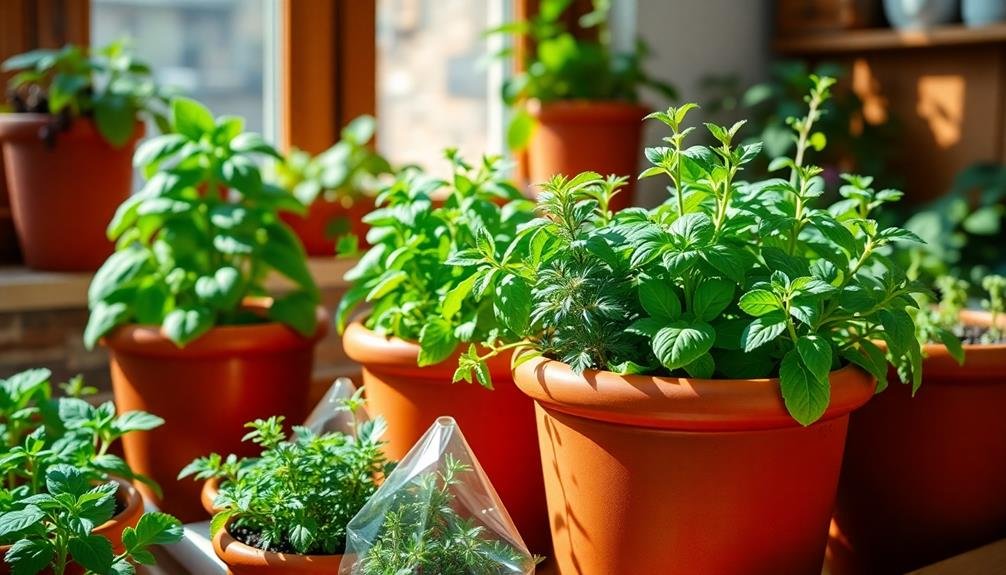
To enhance the flavor of your indoor herbs, choosing the right fertilizer is essential.
You'll also need to pay attention to when you apply it, as timing can greatly impact growth.
Consider whether you prefer organic or synthetic options, as each has its benefits for flavor and health.
Choosing the Right Fertilizer
While many indoor gardeners focus on watering and light, the right fertilizer can greatly enhance the flavor of your herbs. Selecting the appropriate fertilizer can make a significant difference in the taste and aroma of your plants.
Here's what to take into account when choosing a fertilizer:
- Nutrient Balance: Look for a balanced fertilizer, typically with equal parts nitrogen, phosphorus, and potassium (N-P-K). This guarantees your herbs grow strong and flavorful.
- Organic vs. Synthetic: Organic fertilizers, like compost or fish emulsion, can improve flavor by providing slow-release nutrients and beneficial microbes. Synthetic options may deliver quick results but can lack depth in flavor.
- Slow-Release Formulas: Think about using slow-release fertilizers to provide a steady supply of nutrients over time. This helps prevent nutrient burn and promotes healthy growth.
- Herb-Specific Formulas: If available, opt for fertilizers specifically designed for herbs. These are tailored to meet the unique needs of culinary plants and can enhance their flavor profiles.
With the right fertilizer, you'll not only support your herbs' growth but also elevate the taste of your homegrown teas.
Timing Your Applications
Timing your fertilizer applications is essential for maximizing the flavor of your indoor herbs. You want to guarantee that your herbs receive nutrients when they need them most, which can considerably influence their growth and taste.
Start by fertilizing your herbs during their active growing season, typically in spring and summer. This is when they'll benefit from the extra nutrients to develop robust flavors.
Apply fertilizer every four to six weeks, but pay attention to the specific needs of each herb. For instance, basil and mint thrive on more frequent feedings, while rosemary and thyme require less.
Additionally, consider the growth stage of your herbs. When they're young and establishing roots, a lighter application is best. As they mature, you can increase the dosage slightly.
Avoid fertilizing right before harvesting, as the nutrients can alter the flavor profile. Instead, fertilize a couple of weeks before you plan to harvest. This timing helps your herbs absorb the nutrients without compromising the taste you desire in your tea.
Organic vs. Synthetic Options
Choosing between organic and synthetic fertilizers can greatly impact the flavor of your indoor herbs. Each option has its pros and cons, and understanding them will help you make an informed choice that enhances your tea's taste.
Here are four key points to evaluate:
1. Nutrient Release: Organic fertilizers release nutrients slowly, allowing herbs to absorb them over time, which can lead to a richer flavor.
Synthetic fertilizers, on the other hand, provide quick nutrient bursts, which might result in faster growth but can compromise flavor.
2. Soil Health: Organic options improve soil structure and encourage beneficial microorganisms.
Healthy soil promotes better flavor development in herbs.
Synthetic fertilizers often lack this benefit, focusing solely on plant growth.
3. Flavor Profiles: Many gardeners find that herbs grown with organic fertilizers have more complex flavors.
If you're after a unique taste in your tea, organic might be the way to go.
4. Environmental Impact: Organic fertilizers are generally more eco-friendly, supporting sustainable gardening practices.
Synthetic options can contribute to soil degradation and water pollution.
Ultimately, your choice will depend on your gardening philosophy and desired flavor outcomes.
Pruning and Harvesting Tips
When you regularly prune and harvest your indoor herbs, you not only promote healthy growth but also enhance their flavor. Start by using clean, sharp scissors or pruning shears to avoid damaging the plants. Aim to prune your herbs when they reach about six inches tall, cutting just above a leaf node. This encourages bushier growth and prevents leggy plants.
Harvesting should be done frequently, especially for herbs like basil and cilantro. Snip off the top leaves, which are the most flavorful, and leave the lower leaves to continue growing. Always take no more than one-third of the plant at a time to guarantee it stays healthy and vibrant.
Timing is key, too. Early morning is ideal for harvesting, as the oils are at their peak concentration. If possible, avoid harvesting during flowering, as the flavor can diminish when herbs focus on reproduction.
Lastly, remember to rotate your herbs to guarantee even light exposure, promoting balanced growth. By regularly pruning and harvesting, you'll create a thriving indoor herb garden that not only looks great but also delivers rich flavors for your teas.
Pest Management Strategies
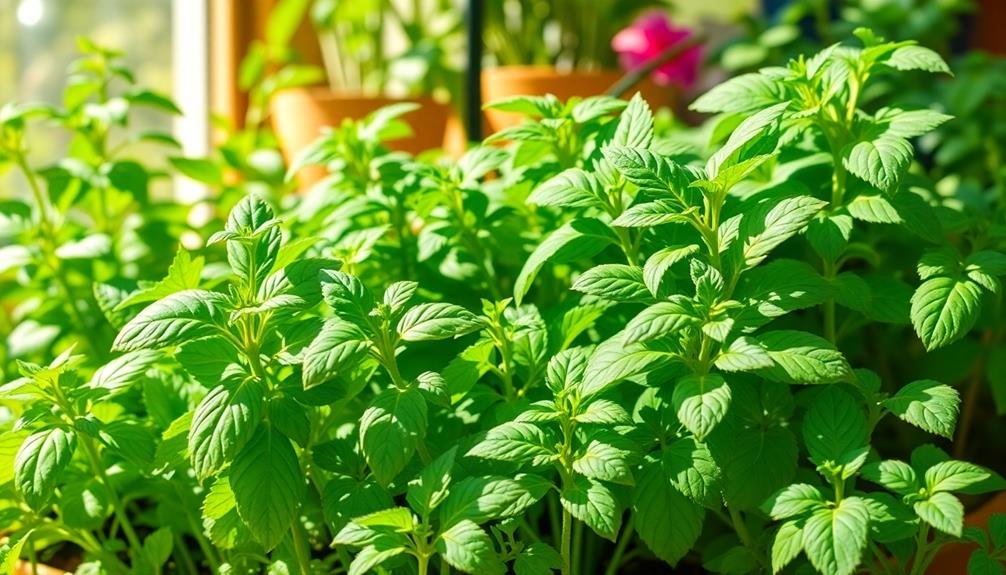
Protecting your indoor herbs from pests is crucial for maintaining their health and vibrancy. Pests can quickly damage your plants, impacting both their growth and the flavor of your herbs.
Here are some effective pest management strategies to keep your herbs thriving:
- Regular Inspection: Check your plants weekly for any signs of pests, such as discoloration or webbing. Early detection is key to preventing infestations.
- Natural Predators: Introduce beneficial insects, like ladybugs or lacewings, that can help control pest populations naturally without harming your herbs.
- Neem Oil Spray: Apply a diluted neem oil solution to your herbs to deter pests. It's a natural pesticide that won't harm your plants when used correctly.
- Quarantine New Plants: Before adding new herbs to your indoor garden, keep them separate for a couple of weeks. This helps guarantee you're not introducing any pests into your existing plants.
Temperature Control
Maintaining the right temperature is essential for the health of your indoor herbs. Most herbs thrive in temperatures between 65°F and 75°F during the day, and they prefer a slightly cooler range at night. If your space gets too hot, your herbs may become leggy and weak, struggling to produce the flavors you desire. Conversely, temperatures that dip too low can stunt their growth or even kill them.
To guarantee your herbs stay healthy, place them away from drafts, heating vents, and air conditioning units. These can create fluctuations that stress your plants. Instead, find a stable location where they can bask in indirect sunlight.
You might also consider using a thermometer to monitor the environment around your herbs. If you notice that the temperature consistently strays from the ideal range, think about relocating them or adjusting your indoor climate.
If you're growing herbs in a greenhouse or a sunny window, be mindful of overheating. During hot days, you may need to provide shade or ventilation.
Indoor Humidity Levels
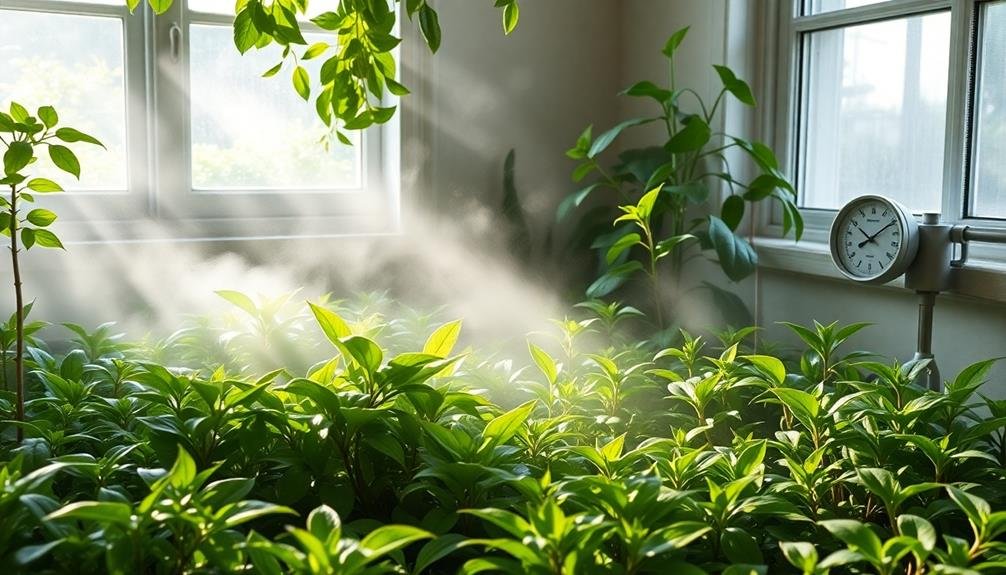
Indoor humidity levels play an essential role in the importance of your herbs, as most thrive in a range between 40% and 60% humidity.
If the air is too dry, your herbs may suffer, leading to wilting or stunted growth. Conversely, excessive humidity can create a breeding ground for mold and pests.
To maintain the ideal humidity for your indoor herb garden, consider these tips:
- Use a Humidifier: This is a straightforward way to add moisture to the air, especially during dry winter months.
- Group Herbs Together: Placing your herbs close can create a microenvironment with higher humidity, benefiting all the plants.
- Misting: Lightly misting your herbs with water can temporarily boost humidity, but don't overdo it—too much moisture can promote mold growth.
- Pebble Trays: Fill a shallow tray with pebbles and water beneath your pots. As the water evaporates, it raises the humidity around your herbs.
Companion Planting Benefits
Companion planting can really boost your indoor herb garden's success.
By pairing certain herbs together, you can enhance their flavors, deter pests, and even improve nutrient uptake.
Let's explore how these strategies can elevate your herb care routine.
Enhanced Flavor Profiles
Flavor enhancement in herbs can transform your culinary creations, and one of the best strategies to achieve this is through companion planting.
When you grow herbs alongside each other, their flavors can intensify and complement one another, providing a richer taste for your teas and dishes.
Here are four key benefits of companion planting that boost flavor profiles:
- Flavor Synergy: Some herbs, like basil and tomatoes, enhance each other's flavors when grown together, creating a more complex taste in your tea blends.
- Nutrient Sharing: When you plant herbs together, they can share nutrients from the soil, leading to healthier, more flavorful plants.
- Microclimate Creation: Companion plants can create a favorable microclimate, which helps herbs thrive and develop stronger, more vibrant flavors.
- Diverse Aroma: Growing a variety of herbs together can produce a unique aroma, contributing to an overall enhanced flavor experience in your teas.
Pest Deterrence Strategies
Growing herbs indoors not only enhances their flavor profiles but also provides an effective strategy for keeping pests at bay. By using companion planting techniques, you can create a natural pest deterrent within your indoor garden. Some herbs, like basil and mint, emit strong aromas that many pests find unappealing. Planting these alongside your favorite tea herbs can help keep unwanted insects away.
You can also mix herbs that attract beneficial insects, like ladybugs and lacewings. These helpful critters feast on pests, providing an additional layer of protection. For instance, pairing rosemary with your tea herbs can deter aphids and spider mites.
Regularly checking your plants for signs of pests is essential. If you spot any issues, you can quickly remove affected leaves or use natural remedies, like neem oil.
Nutrient Synergy Effects
The right combination of herbs can greatly enhance nutrient availability and uptake in your indoor garden. By practicing companion planting, you can create a synergistic environment that benefits all your herbs, ultimately boosting the flavor of your tea.
Here are four key ways to optimize nutrient synergy:
- Nitrogen Fixation: Planting legumes like clover with your herbs can improve nitrogen levels in the soil, benefiting leafy herbs such as basil and mint.
- Pest Control: Some herbs, like rosemary, can repel pests that might harm other plants, allowing your more delicate herbs to thrive and absorb nutrients more effectively.
- Root Interactions: Different root structures can help aerate the soil. For example, shallow-rooted herbs like chives can coexist with deeper-rooted ones like parsley, promoting better nutrient uptake.
- Flavor Enhancement: Certain herbs enhance the oils in their neighbors. For instance, growing thyme alongside rosemary can amplify their flavors, resulting in a more aromatic tea.
Timing for Maximum Flavor

Harvesting herbs at the right time can greatly enhance their flavor and aroma. To get the most out of your indoor herbs, it's crucial to know when to pick them. Generally, the best time to harvest is just before the plant flowers. This is when the leaves are packed with the highest concentration of essential oils, which contribute to the herb's flavor profile.
Early morning is often the best time for harvesting. At this time, the dew has evaporated, and the plants are at their freshest. If you can, wait until the sun has risen but before it gets too hot. This way, the leaves retain their oils, giving you the best flavor in your tea.
For herbs like basil, mint, and thyme, snip the stems just above a set of leaves. This encourages new growth and guarantees you'll have a steady supply.
Avoid overharvesting; always leave enough foliage for the plant to thrive. By timing your harvest correctly, you'll elevate your herbal teas, bringing out the rich flavors that make each cup a delightful experience.
Frequently Asked Questions
How Do I Know When to Harvest My Herbs for Tea?
You'll know it's time to harvest your herbs when they've reached their full size and the leaves are vibrant. Snip them just before flowering for the best flavor, usually in the morning after dew has dried.
Can I Grow Herbs From Kitchen Scraps Indoors?
Yes, you can grow herbs from kitchen scraps indoors! Simply place cuttings in water until roots form, then transfer them to soil. Herbs like basil, green onions, and mint thrive this way, adding freshness to your kitchen.
What Herbs Grow Best Together in Small Spaces?
When growing herbs in small spaces, consider pairing basil, parsley, and chives. They thrive together, sharing similar light and water needs. You'll maximize your harvest and create a vibrant indoor garden with these selections.
How Do Indoor Herbs Affect Tea Caffeine Levels?
Indoor herbs don't directly affect tea's caffeine levels. However, they can enhance flavor and aroma, making your tea experience richer and more enjoyable. So, focus on choosing herbs that complement your favorite tea varieties.
Can I Use Dried Herbs From My Indoor Garden?
Yes, you can use dried herbs from your indoor garden! Just guarantee they're properly dried and stored. Using your homegrown herbs adds unique flavors to your teas, enhancing your overall tea-drinking experience. Enjoy experimenting!
In Summary
By following these indoor herb care secrets, you can greatly enhance the flavor of your tea. Selecting the right herbs, providing ideal light, and mastering watering techniques are just the beginning. Pay attention to soil composition, fertilize wisely, and keep an eye on temperature and humidity levels. Don't forget the benefits of companion planting and timing your harvest for peak flavor. With a little effort, you'll enjoy a deliciously aromatic cup of tea that reflects your care and attention.


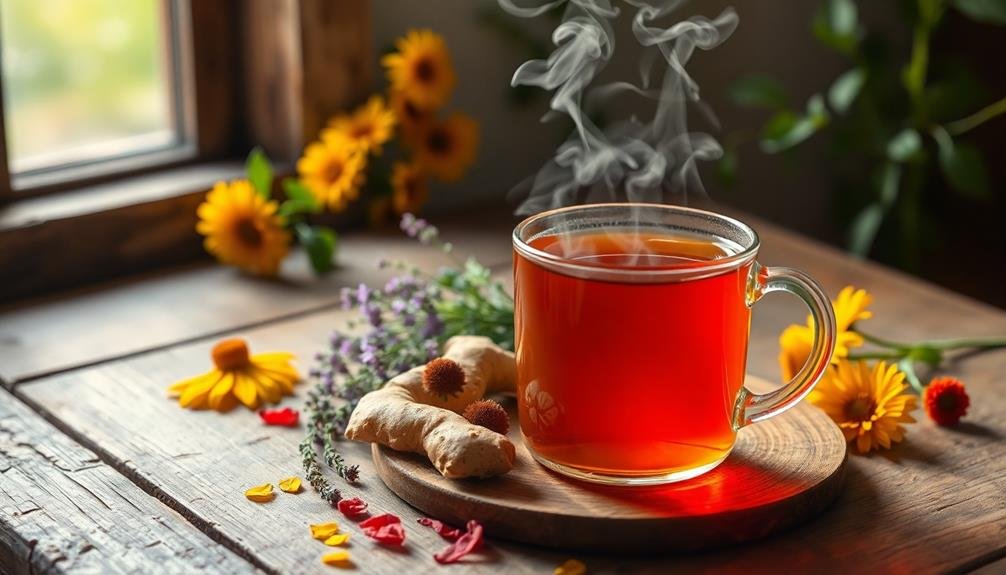
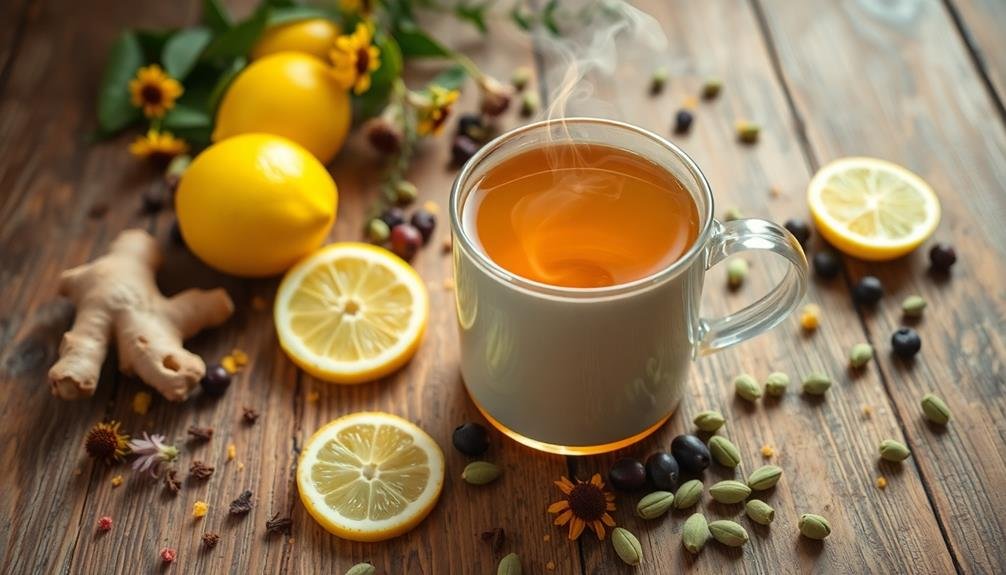
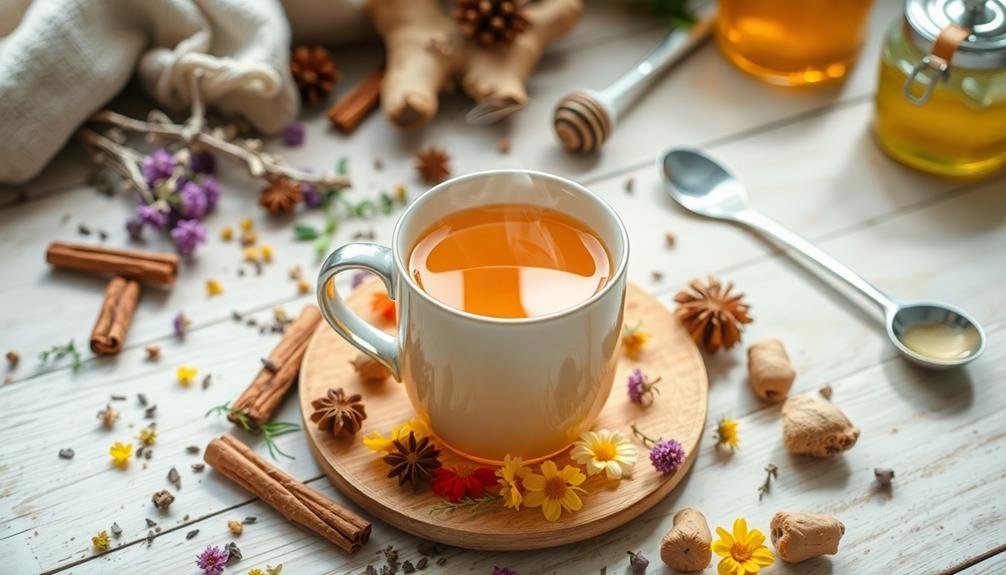
Leave a Reply